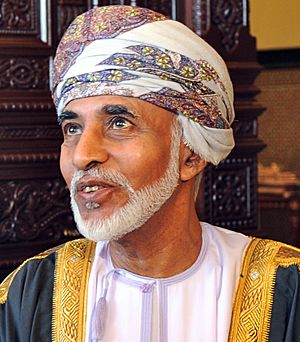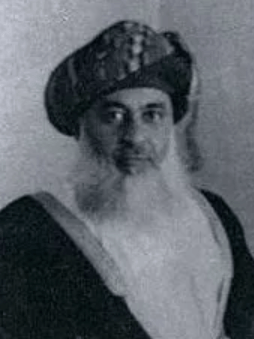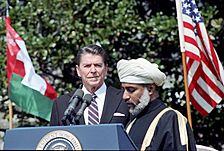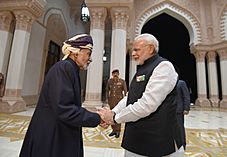Qaboos bin Said facts for kids
Quick facts for kids Qaboos bin Said |
|||||
|---|---|---|---|---|---|

Sultan Qaboos in 2013
|
|||||
| Sultan of Oman Minister of Finance, Defence and Foreign Affairs |
|||||
| Reign | 23 July 1970 – 10 January 2020 | ||||
|
Prime Minister
|
Tariq bin Taimur (1970–1972)
Himself (1972–2020) |
||||
| Predecessor | Said bin Taimur | ||||
| Successor | Haitham bin Tariq | ||||
| Prime Minister of Oman | |||||
|
In office
|
1972 – 10 January 2020
|
||||
|
Deputy
|
Fahd bin Mahmoud al Said (1972–2020)
Asa'ad bin Tariq bin Taimur al Said (2017–2020) |
||||
| Predecessor | Tariq bin Taimur | ||||
| Successor | Haitham bin Tariq | ||||
| Born | 18 November 1940 Salalah, Muscat and Oman |
||||
| Died | 10 January 2020 (aged 79) Seeb, Muscat Governorate, Oman |
||||
|
Buried
|
11 January 2020
Royal Cemetery, Muscat |
||||
| Spouse |
Sayyida Nawwal bint Tariq
(m. 1976; div. 1979) |
||||
|
House
|
Al Said
|
||||
|
|||||
| Father | Said bin Taimur | ||||
| Mother | Mazoon al-Mashani | ||||
| Religion | Ibadi Islam | ||||
| Signature | |||||
Qaboos bin Said Al Said (Arabic: قابوس بن سعيد آل سعيد; born 18 November 1940 – died 10 January 2020) was the Sultan of Oman. He ruled from 23 July 1970 until his death in 2020. He was a descendant of the family that founded the House of Al Said.
At the time of his death, Sultan Qaboos was the longest-serving leader in the Middle East and the Arab world. He had ruled Oman for nearly 50 years.
Qaboos was the only son of Said bin Taimur, who was the Sultan before him. He went to school in Suffolk, England. After finishing his studies at the Royal Military Academy Sandhurst, he served a short time in the British Army.
He came back to Oman in 1966. His father placed many restrictions on him. In 1970, Qaboos became the Sultan of Oman. He took over from his father with support from Britain. After this, the country was renamed the Sultanate of Oman.
As Sultan, Qaboos worked to make Oman a modern country. He also ended Oman's isolation from other nations. During his rule, the quality of life improved for people in Oman. He also helped develop the country, ended slavery, and introduced Oman's constitution. Sultan Qaboos died in 2020 after a period of illness. He had no children. Before his death, he wrote a secret letter naming his successor. After his death, the royal court chose his cousin, Haitham bin Tariq, to be the new Sultan.
Contents
Early Life and Education

Qaboos bin Said was born on 18 November 1940. He was born in Salalah in Dhofar, a southern city in Oman. He was the only son of Sultan Said bin Taimur and Mazoon al-Mashani.
He went to primary and secondary school in Salalah. At age 16, he went to a private school in England. When he was 20, he joined the Royal Military Academy Sandhurst. He graduated from Sandhurst in September 1962.
After that, he joined the British Army. He served with the 1st Battalion of The Cameronians (Scottish Rifles) in Germany for one year. He also worked in a staff role for the British Army.
After his military service, Qaboos studied local government in England. He then traveled the world with a guide. When he returned to Oman in 1966, his father kept him mostly confined to Al-Husun Palace in Salalah. He was kept away from government matters. He only received occasional updates from his father's advisors.
Qaboos spent this time studying Islam and the history of Oman. He had limited contact with others. His father did not want him involved in the country's development plans. Qaboos began to express his wish for changes in Oman. Some visitors quietly supported his ideas.
Political Career
Becoming Sultan of Oman

Qaboos became Sultan on 23 July 1970. He took over from his father. His goal was to end Oman's isolation. He also wanted to use the country's oil money for modernizing Oman. He announced that the country would be called "the Sultanate of Oman." This name showed its political unity.
The change in leadership was supported by the British. It was planned in London by MI6 and government officials. The British Prime Minister, Harold Wilson, approved it.
One of the first big challenges Qaboos faced was a communist uprising. This was the Dhofar Rebellion (1962–1976) from South Yemen. Oman defeated this uprising with help from the Shah of Iran, Jordanian troops, British Special Forces, and the Royal Air Force.
Sultan Qaboos's Rule
When Qaboos became Sultan, Oman was not a modern country. It had very little infrastructure, healthcare, or education. There were only about six miles of paved roads. Most people relied on farming and fishing to live.
Qaboos used money from oil to modernize Oman. He built schools and hospitals. He also created modern infrastructure. Hundreds of kilometers of new roads were paved. A telecommunications network was set up. Projects for a port and airport were finished. A second port was built, and electricity became available.
The government also looked for new water sources. They built a plant to remove salt from seawater. The government encouraged private businesses to grow. Banks, hotels, insurance companies, and newspapers started to appear. The Omani riyal became the national money. In his first year, Qaboos also ended slavery in Oman.
The political system Qaboos created was an absolute monarchy. This means the Sultan had all the power. The Sultan's birthday, 18 November, is Oman's national holiday. The first day of his rule, 23 July, is called Renaissance Day.
During his rule, all power was with the Sultan. He was the head of the armed forces. He was also the minister of defense and foreign affairs. He was the chairman of the Central Bank. All laws since 1970 were made by royal decrees. This included the 1996 Basic Law, which is like Oman's constitution. The Sultan appointed judges and could pardon people. The Sultan's authority was seen as unbreakable.
Protests in Oman (2011)
In 2011, there were protests in Oman. These were part of the "Arab Spring" movement. Protesters asked for higher salaries and lower living costs. They also wanted more jobs and less corruption. Protests in Sohar, Oman's fifth-largest city, happened around the Globe Roundabout.
Sultan Qaboos responded by making some changes. He dismissed a third of the government cabinet. He also gave some small concessions to the protesters. However, some social media activists were detained.
Oman's Foreign Policy

Under Qaboos, Oman had closer ties with Iran than other Arab countries in the Persian Gulf. Oman tried to stay neutral and keep a balance between Western countries and Iran. Because of this, Oman often helped as a go-between for the United States and Iran.
In 2013, Qaboos helped arrange secret talks between the US and Iran. These talks led to an international nuclear agreement two years later. The United States later left this agreement in 2018.
In 2011, Qaboos helped free American hikers who were held in Iran. He paid $1 million for their release.
Oman did not join the military action led by Saudi Arabia in Yemen in 2015. Oman also did not take sides in a dispute in 2017. This dispute involved Saudi Arabia and its allies placing an embargo on Qatar.
In October 2018, Qaboos invited Prime Minister of Israel Benjamin Netanyahu to visit Oman. Oman does not have official diplomatic ties with Israel. Netanyahu was the first Israeli prime minister to visit Oman since 1996.
Helping Others and the Environment
Qaboos helped pay for building or maintaining many mosques. The Sultan Qaboos Grand Mosque is one example. He also supported the holy places of other religions.
In the early 1990s, Qaboos gave money to UNESCO. This money created the Sultan Qaboos Prize for Environmental Preservation. This award recognizes great efforts in managing or protecting the environment. The prize has been given out every two years since 1991.
Personal Interests
Qaboos was a Muslim of the Ibadi branch of Islam. This branch has traditionally ruled Oman. Even though Oman is mostly Muslim, the Sultan allowed freedom of religion. He helped pay for building four Catholic and Protestant churches. He also helped build several Hindu temples in the country.
The Sultan loved and supported classical music. His orchestra had 120 members. All of them were young Omanis. They auditioned as children and grew up playing in the orchestra. They played in Oman and traveled abroad with the Sultan. A composer named Lalo Schifrin wrote music about Oman for the orchestra.
Qaboos especially liked the pipe organ. The Royal Opera House Muscat has one of the largest mobile pipe organs in the world. It has three special organ sounds named "Royal Solo" in his honor. He also supported local folk musician Salim Rashid Suri, making him a cultural consultant.
On 22 March 1976, Qaboos married his cousin, Sayyida Nawwal bint Tariq Al Said. She is the daughter of his uncle, Sayyid Tariq bin Taimur Al Said. Nawwal is also a half-sister of Qaboos's successor, Haitham bin Tariq. The marriage ended in divorce in 1979. They did not have any children.
In September 1995, Qaboos was in a car accident in Salalah. One of his important ministers, Qais Bin Abdul Munim Al Zawawi, died in the accident.
Qaboos owned several large yachts. These were managed by the Oman Royal Yacht Squadron. His yachts included Al Said and Fulk Al Salamah. These are among the world's largest yachts.
Illness and Passing
From 2014, Qaboos had health problems. He received medical treatment for his illness. On 14 December 2019, he was reported to be very ill. He returned home from Belgium because he wanted to be in Oman.
He passed away on 10 January 2020 at age 79. He died at his home, Bait Al-Baraka, near Muscat. The next day, the government announced three days of national mourning. The country's flag would be flown at half-mast for 40 days. Official work in public and private sectors stopped for three days. Several other countries also declared days of mourning. The United Kingdom lowered its flags to half-mast to show respect.
Choosing a New Sultan
Unlike leaders in some other Arab countries, Qaboos did not publicly name who would take over after him. Oman's constitution says the Royal Family Council has three days to choose a new sultan. If they cannot agree, a letter written by Sultan Qaboos would be opened. This letter would name his chosen successor. It would be opened in front of military and security officials, supreme court chiefs, and heads of the consultative assemblies.
Experts believed these rules were a way for Qaboos to ensure his choice was followed. It was thought unlikely the royal family would agree on their own.
Qaboos had no children. He had only one sister, Sayyida Umaima, but no brothers. There are other male members of the Omani royal family. Following the family rules, the successor would likely be one of the sons of his late uncle, Sayyid Tariq bin Taimur. Tariq was Oman's first prime minister and Qaboos's former father-in-law.
People who studied Oman believed the main candidates were three of Tariq's sons: Asa'ad bin Tariq, Shihab bin Tariq, and Haitham bin Tariq.
On 11 January 2020, Oman state TV announced that the Royal Family Council had decided to follow Qaboos's will. They opened the letter from Qaboos naming his successor. Shortly after, they announced that Haitham bin Tariq was the new Sultan of Oman. Haitham has two sons and two daughters.
Awards and Honors
| Styles of Sultan of Oman |
|
|---|---|
 |
|
| Reference style | His Majesty |
| Spoken style | Your Majesty |
Omani Honors
 Oman:
Oman:
 Grand Master of the Order of Al-Said
Grand Master of the Order of Al-Said Grand Master of the Order of Oman
Grand Master of the Order of Oman Grand Master of the Order of the Renaissance of Oman
Grand Master of the Order of the Renaissance of Oman Grand Master of the Order of Merit of Sultan Qaboos
Grand Master of the Order of Merit of Sultan Qaboos Grand Master of the Order of N'Oman
Grand Master of the Order of N'Oman Grand Master of the Order of Merit
Grand Master of the Order of Merit Grand Master of the Order of Sultan Qaboos
Grand Master of the Order of Sultan Qaboos Grand Master of the Sultan Qaboos Order for Culture, Science and Art
Grand Master of the Sultan Qaboos Order for Culture, Science and Art Grand Master of the Order of Appreciation
Grand Master of the Order of Appreciation Grand Master of the Order of Achievement
Grand Master of the Order of Achievement
International Honors
 Austria:
Austria:
 Grand Star of the Decoration of Honour for Services to the Republic of Austria (31 March 2001)
Grand Star of the Decoration of Honour for Services to the Republic of Austria (31 March 2001)
 Bahrain:
Bahrain:
 Brunei:
Brunei:
 Egypt:
Egypt:
 France:
France:
 Grand Cross of the Legion of Honour (31 May 1989)
Grand Cross of the Legion of Honour (31 May 1989)
 Germany:
Germany:
 Grand Cross Special Class of the Order of Merit of the Federal Republic of Germany
Grand Cross Special Class of the Order of Merit of the Federal Republic of Germany
 India:
India:
 Jawaharlal Nehru Award for International Understanding (2004 – award yet to be presented)
Jawaharlal Nehru Award for International Understanding (2004 – award yet to be presented)- Gandhi Peace Prize (03/2021), Delhi
 Indonesia:
Indonesia:
 Iran:
Iran:
 Italy:
Italy:
 Knight Grand Cross with Collar of the Order of Merit of the Italian Republic (22 April 1974)
Knight Grand Cross with Collar of the Order of Merit of the Italian Republic (22 April 1974)
 Japan:
Japan:
 Jordan:
Jordan:
 Kuwait:
Kuwait:
 Lebanon:
Lebanon:
 Malaysia:
Malaysia:
 Morocco:
Morocco:
 Netherlands:
Netherlands:
 Pakistan:
Pakistan:
 Recipient of the Nishan-e-Pakistan, 1st Class
Recipient of the Nishan-e-Pakistan, 1st Class
 Qatar:
Qatar:
 Saudi Arabia:
Saudi Arabia:
 Singapore:
Singapore:
 South Africa:
South Africa:
 Spain:
Spain:
 Knight of the Collar of the Order of Isabella the Catholic (13 December 1985)
Knight of the Collar of the Order of Isabella the Catholic (13 December 1985) Grand Cross of the Order of Civil Merit
Grand Cross of the Order of Civil Merit
 Syria:
Syria:
 Tunisia:
Tunisia:
 Grand Cordon of the Order of the Republic
Grand Cordon of the Order of the Republic Collar of the Order of Independence
Collar of the Order of Independence
 United Arab Emirates:
United Arab Emirates:
 United Kingdom:
United Kingdom:
 Honorary Knight Grand Cross of the Order of the Bath (GCB) (18 March 1982)
Honorary Knight Grand Cross of the Order of the Bath (GCB) (18 March 1982) Honorary Knight Grand Cross of the Order of St Michael and St George (GCMG) (8 July 1976)
Honorary Knight Grand Cross of the Order of St Michael and St George (GCMG) (8 July 1976) Recipient of the Royal Victorian Chain (27 November 2010)
Recipient of the Royal Victorian Chain (27 November 2010) Honorary Knight Grand Cross of the Royal Victorian Order (GCVO) (28 February 1979)
Honorary Knight Grand Cross of the Royal Victorian Order (GCVO) (28 February 1979) Associate Bailiff Grand Cross of the Venerable Order of Saint John (GCStJ) (19 March 1984)
Associate Bailiff Grand Cross of the Venerable Order of Saint John (GCStJ) (19 March 1984) Associate Knight of Justice of the Venerable Order of Saint John (KStJ) (8 November 1976)
Associate Knight of Justice of the Venerable Order of Saint John (KStJ) (8 November 1976)
Legacy
A special Euro note was made to remember Qaboos. In June 2022, his Service Medal of the Order of St John was officially honored in London.
See also
 In Spanish: Qabus bin Said Al Said para niños
In Spanish: Qabus bin Said Al Said para niños
- List of longest-reigning monarchs
- Royal Guard of Oman



